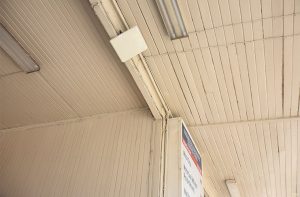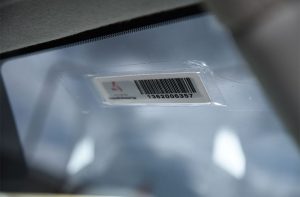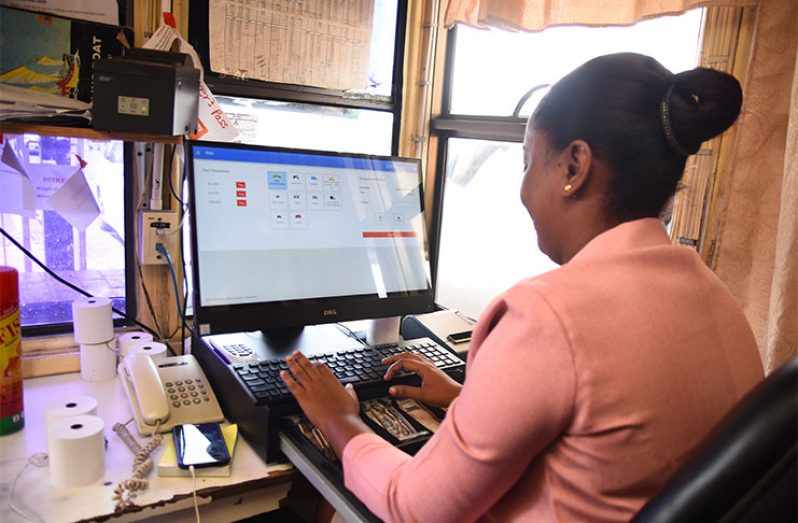ALMOST 10,000 vehicles traverse the Demerara Harbour Bridge daily and these, before the end of the year, will have access to an automated toll-collection system which saves time and increases data management.
The Demerara Harbour Bridge Corporation (DHBC) Electrical Engineer Andre Crowder and Traffic Coordinator, Hazelu Richardson, sat down with this newspaper recently to give a detailed sneak preview of the transformation to come.

The new system utilises Radio-Frequency Identification (RFID), a form of wireless communication which uses electromagnetic fields to automatically identify and track tags attached to objects.
The system presents a shorter and instantaneous process of producing a ticket and enables drivers to simply drive up to the toll booth, collect their tickets and continue on their way.
Drivers can even pass through the toll booth without stopping, as an electronic receipt of their payment will be accessible on line. Additionally, toll booth operators will have the option of utilising the cash-based system for drivers without the RFID tag, or any driver who simply wishes to pay with cash.
The new system is still in its testing phase, but in a month’s time, the DHBC hopes to implement the same, beginning with its eight charge-companies.
The entire project is being funded through the corporation’s toll revenue with phase one costing some $5.5M, while phase two will include gradual, wide-scale installation.
THIS IS THE FUTURE
Explaining the challenges of the present system, the officials stated that the ticketing software had numerous categories of selection to meet one end goal and was prone to freezing, which would oftentimes prevent the company from receiving a tally of the revenue collected for the day.
The system, created in 2008, also contributes to long delays when toll booth operators have to manually write up tickets for companies utilising the bridge by charge bills.
“This would slow up the traffic during peak periods and once one of these computers begins to hang, the whole system will hang and you will have to manually write the ticket information until you get the system working,” Crowder explained.

On the other hand, the new software presents fewer options; has an online means of making payments; reduces the likeliness of errors and the amount of cash stored at the booths.
How it works is through the scanning of the RFID tag by a sleek machine, which has been placed above the toll booths.
One of the RFIDs being used for testing seen by the newspaper was placed on the top right-hand corner of a DHBC vehicle, taking up very little space.
“When the vehicle comes up, the RFID recognises that vehicle and then it automatically sends this to the system to print this vehicle number; that’s once the vehicle has money inside the account. If the vehicle does not have money inside the account, it’s going to show up [on the computer] that the vehicle does not have any balance and we can cash it directly,” Crowder explained.
The first installation of the RFID tag on vehicles will be free of cost, but if this is damaged, the vehicle owner or driver will have to bear the replacement cost.
When it comes to the electronic payment, the DHBC is still deciding on the means through which drivers will pay for the tickets, with Mobile Money Guyana (MMG) being only one of several options available.
The application was created by local IT company Smartware Solutions, as a means of empowering local businesses and encouraging more local companies to excel in Information and Communications Technology (ICT).
Crowder said the team is working on creating an added option for individuals to check their balance online and for automatic emails to be sent to vehicle owners when their balances reach a low level.
The site for the system will also show drivers or companies the trip history of their vehicles.
Meanwhile, the corporation hopes to tie in the same system with ocean-going vessels travelling between the bridge.
BENEFICIAL TO ALL
Telling of what spurred the idea some two years ago for the system, Crowder said: “More than one time we had the issue where if we lost connection with the server, the whole system would shut down. Sometimes, if there are power outages, the whole system shuts down and you have to write tickets for like an hour or two, which contributes to traffic [snarling].”

Richardson added that there were many errors in these cases, as toll booth operators working under pressure would document incorrect information.
“For us, in the Audit Department, it was becoming a problem for us to verify whether or not the correct number was written, or whether it was to the right company,” she said.
Now, the DHBC is also collaborating with the Guyana Revenue Authority (GRA) whereby the information captured can be compared in the authority’s database to capture illegal vehicular activities, which would also be shared with the police.
“The Guyana Revenue Authority would already have information about every licensed vehicle. Now, if it [the vehicle] passes through the system and the information shown is a different information from what actually was registered to the Guyana Revenue Authority, the relevant authority will be flagged. So, if by any chance you know you’re not supposed to have two vehicles carrying the same registration number, if that occurs, it will not affect the normal operations of the cashier, but whoever is supposed to receive that information will receive it,” Richardson said.

Questioned on what would occur in the event that a vehicle with the RFID tag but no money passes through the toll booth without stopping, the DHBC officials stated that this will be flagged on the system and, the next time credit is placed in the vehicle’s account, the previous amount owed will be deducted along with an added fee.
“For the harbour bridge we are one of the most demanded tolling systems,” Richardson stated, adding that: “Besides the vehicles that are crossing the bridge, as it relates to crime, data management and these things, it will benefit not only the commuters, but Guyana on a whole.”
Meanwhile, Crowder said: “We’re looking by September-August to do the full implementation in the remaining booths; that will be for the charge-vehicles. By October-November, then we can branch out into the public.”



.jpg)









